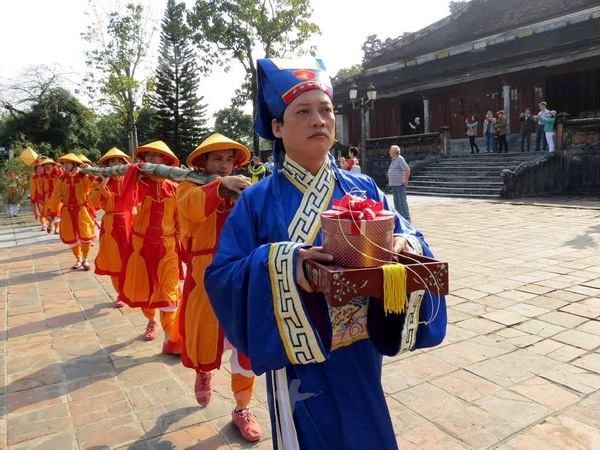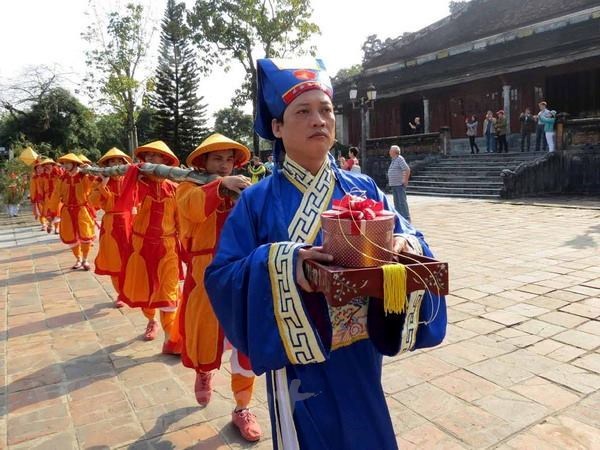
A ceremony to plant Neu pole (a tall bamboo tree with red garment strips used to ward off evil spirits during Tet) was organised at Hue Imperial Citadel in the central province of Thua Thien-Hue on February 8.

Neu pole
erected at Hue Imperial Citadel - Illustrative image (Source: VNA)
The 15-metre bamboo pole was carried by a group of men dressed as soldiers
under the Nguyen Dynasty in a procession from the Hien Nhon Gate through the
Thai Hoa Palace to arrive at the Ancestral Temple, where it was erected.
The erection of the Neu pole on the 23rd day of the 12th lunar month marks the
beginning of Tet. It coincides with the day when the Kitchen Gods are believed
to ride carp fish to the Heaven to report on events from the past year.
During 143 years of reign (1802 – 1945), the Nguyen Dynasty held an annual
ceremony to plant the Neu pole at the Imperial Citadel. The pole carries ritual
items on its top, like a royal seal, a paper scroll and pen, which imply that
the royal court stopped working during Tet.
The Neu pole is also believed to ward off ghosts and demons from entering the
community during Tet. It would also direct ancestors seeking the path home for
the Lunar New Year holiday. The custom is also practised in some Asian
countries besides Vietnam.
It will be taken down on the seventh day of the first lunar month to mark the
end of the Tet celebration.
Also on the day, the Hue Relics Preservation Centre held a Tet programme, which
offers visitors a chance to listen to nha nhac (Hue royal court music), folk
games, and watch a competition to make Chung cake (a cake made from glutinous
rice traditionally dedicated to Tet).
Source: VNA
With an increasingly vibrant and widespread emulation movement aimed at building cultured residential areas and cultured families, Yen Thuy District has been making steady progress toward improving both the material and spiritual well-being of its people, while fostering a civilized, prosperous, beautiful, and progressive community.
Once lacking recreational spaces and community facilities, Residential Group 2 in Quynh Lam Ward (Hoa Binh City) has recently received attention for the construction of a new, spacious, and fully equipped cultural house. The project followed the model of state support combined with public contributions in both labor and funding.
The "All people unite to build cultural life" movement, which has been effectively integrated with Kim Boi district’s socio-economic development goals, is fostering a lively spirit of emulation across local residential areas, hamlets, villages, public agencies, and enterprises. In addition, through the initiative, traditional cultural values are being preserved and promoted, while community solidarity and mutual support in poverty reduction and economic development are being strengthened.
A working delegation of the Hoa Binh provincial People’s Committee led by its Permanent Vice Chairman Nguyen Van Toan on June 11 inspected the progress of a project to build the Mo Muong Cultural Heritage Conservation Space linked to tourism services in Hop Phong commune, Cao Phong district.
Born and growing in the heroic land of Muong Dong, Dinh Thi Kieu Dung, a resident in Bo town of Kim Boi district, in her childhood was nurtured by the sweet lullabies of her grandmother and mother. These melodies deeply imprinted on her soul, becoming an inseparable part of her love for her ethnic group's culture. For over 20 years, this love for her hometown has driven Dung to research, collect, and pass down the cultural values of the Muong people to future generations.
In the final days of May, the Ethnic Art Troupe of Hoa Binh Province organized performances to serve the people in remote, mountainous, and particularly disadvantaged areas within the province. These were not just ordinary artistic shows, but they were the meaningful journeys aimed at spreading cultural values, enhancing the spiritual life of the people and contributing to the preservation of ethnic minority cultural identities.



